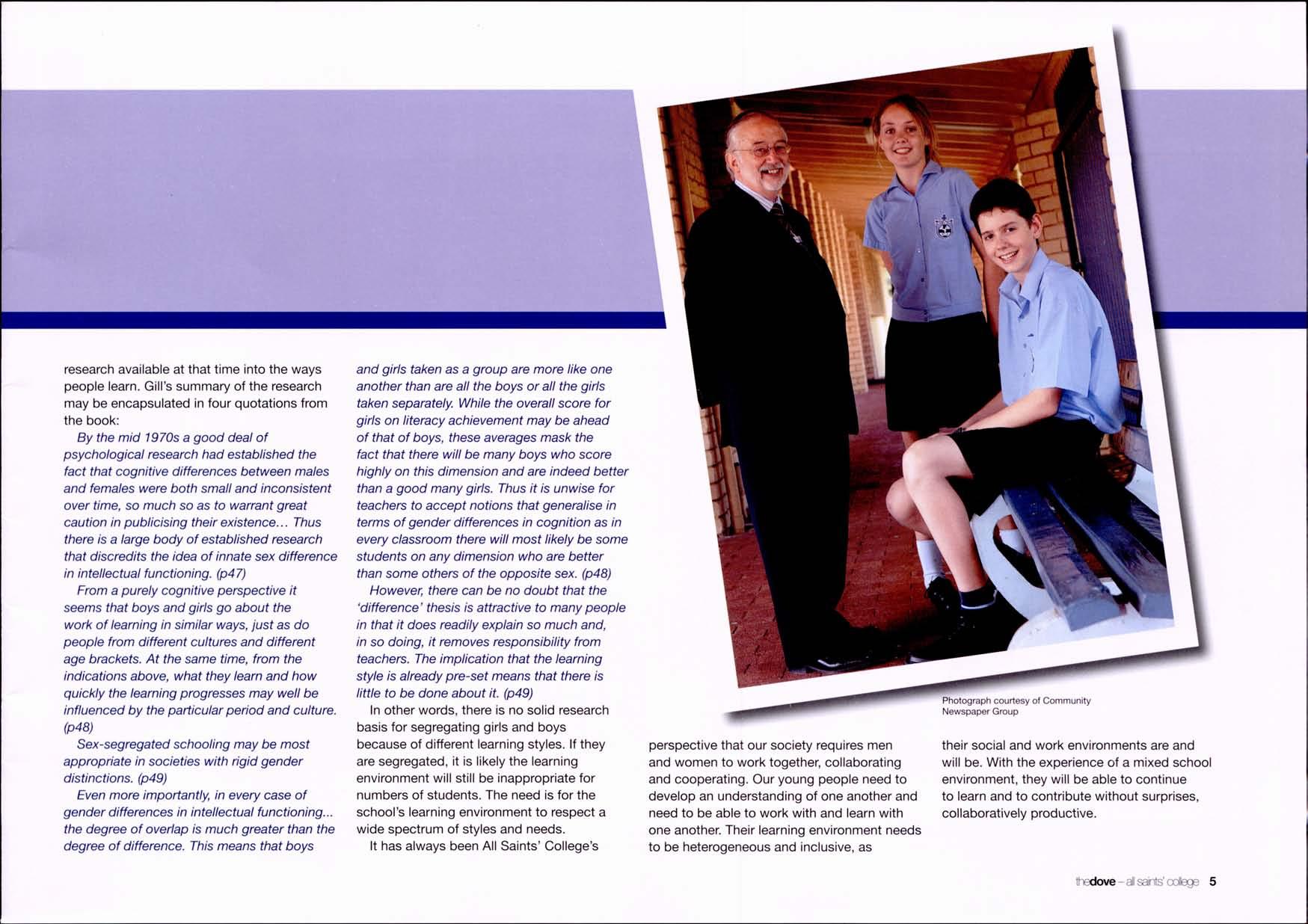
4 minute read
From the Principal
Dr Geoffrey Shaw - Principal
ALL Saints' College Principal Or Geoffrey Shaw will spend the first two months of 2009 in the USA (see page 16). He will examine research on co-education and work with the Heads of several major US private schools, discussing programs which can maximise the learning effectiveness of co-educational schools.
Here, he reflects on co-education in Pertn.
ONE of the common educational debates, one which obviously is of importance to us at All Saints' College, is over the comparative effectiveness of co-education and singlegender schooling. It is a curious situation that some Perth parents who are considering sending their children to All Saints' occasionally see our being co-educational as a peculiarity or even as a disadvantage. The schools they consider as their other options are all-boy or all-girl schools and they assume these provide a higher quality of education.
This is a perspective I encounter from time to time when I interview prospective families, and some of our College parents have reported encountering it among their friends outside the All Saints' community.
I believe there is a simple historical explanation for this: the private schools which have long-standing reputations in Perth are the traditional single-gender schools; these were established in the late nineteenth and early twentieth centuries and were based on old models of the English, boys' "public schools", and the separate set of schools founded to educate, or finish, "young ladies".
All Saints' appeared on the scene decades after the foundation of these traditional Perth schools which had since formed two distinct and easily identified groups through their sporting associations. Because we belong to a different historical period and are not a member of their sporting associations, we are separate. We are now widely regarded as a school of comparable quality but it has taken considerable effort for us to be viewed in that way, and the short-hand thinking still sometimes omits us when quality is equated with membership of the boys' or girls' school sporting associations. This sort of short-hand judgment is much rarer in other Australian states or England or the USA, where larger numbers of high-quality co-educational schools are present as an expected part of the range of choices.
Is there any more substantial, thoroughlyresearched basis on which to compare the quality of the two styles of school?
There is no accepted research showing that either boys or girls achieve more highly in either single-sex or mixed schools. With that furphy failing to find a supporting foundation, when the educational merits of the two forms of schooling are considered now, some people refer to differences in theways boys and girls learn.
In her very important 2004 book, Beyond the Great Divide, Judith Gill considered the
research available at that time into the ways people learn. Gill's summary of the research may be encapsulated in four quotations from the book:
By the mid 1970s a good deal of psychological research had established the fact that cognitive differences between males and females were both small and inconsistent over time, so much so as to warrant great caution in publicising their existence... Thus there is a large body of established research that discredits the idea of innate sex difference in intellectual functioning. (p47)
From a purely cognitive perspective it seems that boys and girls go about the work of learning in similar ways, just as do people from different cultures and different age brackets. At the same time, from the indications above, what they learn and how quickly the learning progresses may well be influenced by the particular period and culture. (p48)
Sex-segregated schooling may be most appropriate in societies with rigid gender distinctions. (p49)
Even more importantly, in every case of gender differences in intellectual functioning... the degree of overlap is much greater than the degree of difference. This means that boys and girls taken as a group are more like one another than are all the boys or all the girls taken separately While the overall score for girls on literacy achievement may be ahead of that of boys, these averages mask the fact that there will be many boys who score highly on this dimension and are indeed better than a good many girls. Thus it is unwise for teachers to accept notions that generalise in terms of gender differences in cognition as in every classroom there will most likely be some students on any dimension who are better than some others of the opposite sex. (p48)
However, there can be no doubt that the 'difference' thesis is attractive to many people in that it does readily explain so much and, in so doing, it removes responsibility from teachers. The implication that the learning style is already pre-set means that there is little to be done about it. (p49)
In other words, there is no solid research basis for segregating girls and boys because of different learning styles. If they are segregated, it is likely the learning environment will still be inappropriate for numbers of students. The need is for the school's learning environment to respect a wide spectrum of styles and needs.
It has always been All Saints' College's perspective that our society requires men and women to work together, collaborating and cooperating. Our young people need to develop an understanding of one another and need to be able to work with and learn with one another. Their learning environment needs to be heterogeneous and inclusive, as

Photograph courtesy of Community Newspaper Group
their social and work environments are and will be. With the experience of a mixed school environment, they will be able to continue to learn and to contribute without surprises, collaboratively productive.










